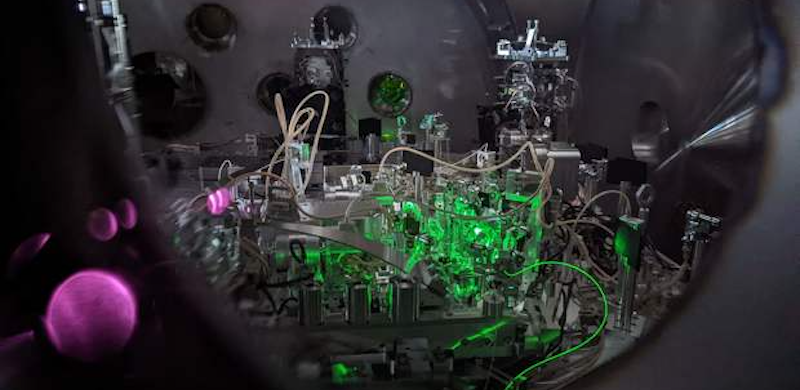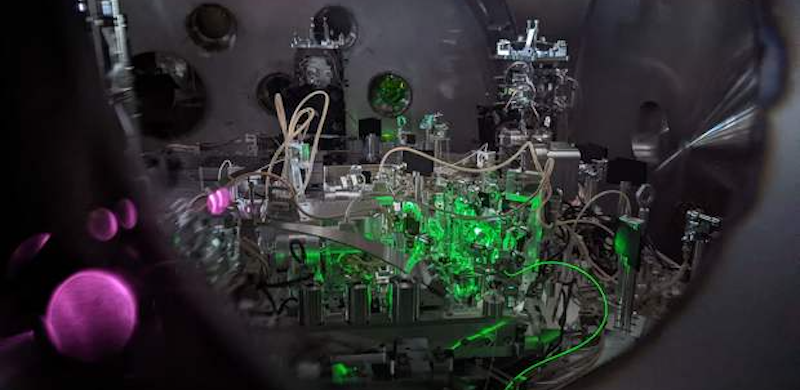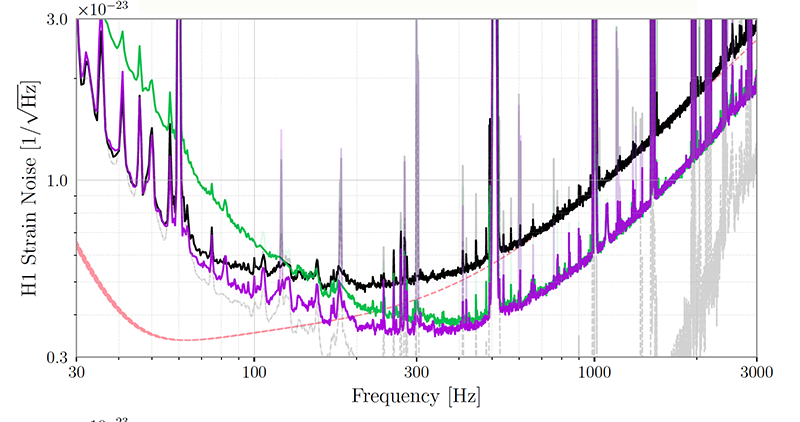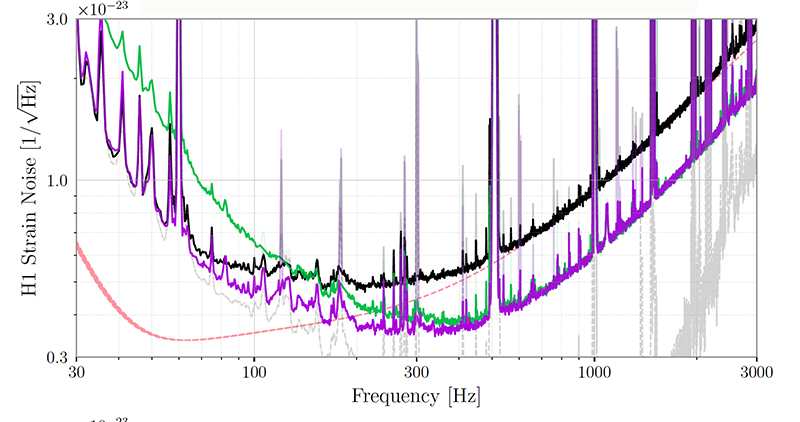Quieting Noise in Gravitational-Wave Detectors
The ability of the LIGO and Virgo gravitational-wave detectors to reveal mergers of compact objects such as black holes and neutron stars is soaring. After recording three and eight mergers in the first and second experimental runs, respectively, the detectors captured 79 mergers in an extraordinary third run between 2019 and 2020. The detection bonanza was enabled by a quantum technology that can “squeeze” detector noise to reveal fainter signals. The fourth run, which kicked off last May, involves an even more sophisticated noise-squeezing technique, called frequency-dependent squeezing. The LIGO Scientific Collaboration now reports tests showing that the technique can optimize noise over the entire range of gravitational-wave frequencies that the instrument can detect [1]. The advance will allow the team to probe a 65% larger volume of the Universe and to gain more detailed information on the sources of the detected gravitational waves.
Gravitational-wave detectors such as LIGO are giant, L-shaped interferometers in which two laser beams travel hundreds of times along two perpendicular arms before they interfere on a detector. As a gravitational wave passes through the interferometer, it distorts in different ways each arm’s length, producing an oscillating interference signal. Thanks to tricks for rejecting all sources of noise—from acoustic and seismic vibrations to thermal fluctuations—the LIGO detector can register length changes that are orders of magnitude smaller than the size of a proton.
At this sensitivity level, the “device is affected by the quantum realm,” says LIGO scientist Lee McCuller of the California Institute of Technology. Quantum effects arise from fluctuations of the quantum vacuum, a state in which particles and photons continuously pop in and out of existence. These vacuum photons can interfere with the laser beam, generating in the detector a quantum “crackle” that can conceal faint signals. Today, quantum noise dominates a large swath of the gravitational-wave frequencies LIGO can detect.
The impact of quantum fluctuations on gravitational-wave detection can be mitigated through noise squeezing, a method proposed about 40 years ago and first deployed at both LIGO and Virgo in 2019 (see Focus: Squeezing More from Gravitational-Wave Detectors). The noise of the quantum vacuum can be represented as an “ellipse,” in which one axis corresponds to uncertainty in phase (the arrival time of the photons) and the other to uncertainty in amplitude (the number of photons). Squeezing refers to the fact that the ellipse can be squashed to shrink one uncertainty component at the expense of the other—a trade-off related to Heisenberg’s uncertainty principle. The approach offers the possibility of reducing a given measurement’s noise by shrinking the component that mostly contributes to it.
In the 2019–2020 runs, the LIGO and Virgo collaborations focused on squeezing the phase component—which dominated noise in most of their frequency range. The core of the squeezer was an optical parametrical oscillator, a device that produces pairs of entangled photons whose timing is correlated. When injected into the beam path from the interferometer to the detector, these photons created a new squeezed vacuum that reduced fluctuations in the arrival time of the laser photons. “The photons arrive more regularly, as if they are holding hands rather than traveling independently,” McCuller says.
LIGO’s upgrades for its fourth run involved more laser power in the interferometer and more phase squeezing. At that point, however, a trade-off emerged. Namely, the growth of amplitude uncertainty associated with the shrinking of phase uncertainty meant that amplitude noise became dominant for gravitational frequencies below 300 Hz. The origin of such low-frequency behavior is linked to a “rumble” caused by the radiation pressure of photons hitting the interferometer’s mirrors, says Lisa Barsotti of the Massachusetts Institute of Technology (MIT) LIGO Lab. While such a rumble would not affect measurements above 300 Hz, it would significantly degrade LIGO’s sensitivity at lower frequencies, she says.
To tackle the problem, the LIGO Scientific Collaboration followed an approach, proposed in 2001, that involves squeezing the noise ellipse differently at different frequencies. This frequency-dependent squeezing is realized by coupling the interferometer to a 300-m-long “filter” cavity. Through the cavity, the team could tailor the spectrum of the squeezed state, injecting amplitude squeezing in the low-frequency region and phase squeezing in the high-frequency region, says Victoria Xu, also of MIT LIGO Lab. “This [approach] allows us to reduce the limiting forms of quantum noise in each frequency band,” she says.
The frequency-dependent approach had previously been demonstrated in tabletop systems but implementing it to mitigate radiation-pressure noise in a full-scale gravitational-wave detector was a massive engineering challenge, Xu says. An important aspect was the minimization of optical losses due to imperfect optical components or to a mismatch of the light modes propagating in the various parts of the setup—the filter cavity, the squeezer, and the interferometer. “Any loss can be seen as a ‘port’ through which regular, nonsqueezed vacuum can enter,” Barsotti says.
The LIGO Scientific Collaboration tested frequency-dependent squeezing during the commissioning of the instrument upgrades for the fourth run, comparing detector noise spectra for no squeezing, frequency-independent squeezing, and frequency-dependent squeezing. Frequency-dependent squeezing yielded similar enhancements to frequency-independent squeezing at high frequencies while eliminating the degradation below 300 Hz due to radiation-pressure noise. The team estimated that the improved noise performance would increase the distance over which mergers can be detected by 15%–18%, corresponding to up to a 65% increase in the volume of the Universe that the LIGO interferometer will be able to probe. Quantum optics specialist Haixing Miao of Tsinghua University in China says this result demonstrates an exceptional ability to manipulate quantum states of light with optical cavities but also offers an impressive demonstration that quantum measurement theory applies to the kilometer scales of a gravitational-wave detector.
The expanded detection volume means that LIGO will be able to detect more binary mergers of both black holes and neutron stars, Barsotti says. A broader catalogue of the population of these compact objects will help researchers learn about how these systems formed. What’s more, LIGO will be able to observe a system at a given distance with higher signal-to-noise ratio, says Bruce Allen of the Max Planck Institute for Gravitational Physics in Germany. Cleaner signals will allow the analysis of subtle effects such as precession of the orbital planes, eccentricity in the orbits, and the presence of “high-order” spectral modes in the signal from the postmerger (ringdown) phase of the detected event, he says. These effects could be used to test the limits of general relativity and possibly reveal new physics. Allen adds that the more sensitive detectors could catch never-before-seen types of gravitational waves, for example, continuous gravitational waves from fast-spinning neutron stars or from more exotic sources such as cosmic strings.
Miao says that the results bode well for a stated goal of next-generation gravitational-wave interferometers such as the Cosmic Explorer and the Einstein Telescope: achieving a factor 10 in power (10 dB) of noise squeezing. Getting there will require in the first place minimizing optical losses. “The new work shows the instrument team has a clear understanding of the sources of optical loss and of what’s needed to reduce them in the future,” Miao says.
–Matteo Rini
Matteo Rini is the Editor of Physics Magazine.
References
- D. Ganapathy et al. (LIGO O4 Detector Collaboration), “Broadband quantum enhancement of the LIGO detectors with frequency-dependent squeezing,” Phys. Rev. X 13, 041021 (2023).







